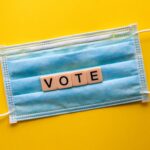As an anthropologist who researches a mental health disorder that I also suffer from, I take this opportunity to reflect on the ways that COVID-19 has affected daily life with a body-focused repetitive behaviour (BFRB). In particular, this piece draws attention to the impact of lockdown in the UK including the advice on face-touching; the triggers of staying at home; the paradox of anxiety; and how isolation can lead to increased social connections.
Don’t touch your face!
Body-focused repetitive behaviours are compulsive mental health disorders including hair pulling (trichotillomania), skin picking (dermatillomania) and nail biting (onychophagia). Clear from the name, these behaviours involve a repetitive, somewhat obsessive interaction with the body. My ongoing research with people living with BFRBs in the UK and US, as well as personal experience living with these behaviours has confirmed that BFRBs are more complex than habits that can be easily overcome. The urges that accompany BFRBs are frequently described to me in terms of addiction, where pleasure and harm are entangled with satisfaction and shame. People with BFRBs usually do not understand why they have the urge to pull out the hair from their bodies or constantly pick their skin. These urges are rarely at ease, and while people attempt to conceal their behaviour from public view, the need to satisfy their bodies through pulling and picking occupies their thoughts most of the time.
In the early advice of COVID-19, media coverage highlighting the risks of face-touching took on a new meaning for my interlocutors. For many people with compulsive skin picking, the face is a site of great obsession. Urges accompany the frequent scanning for imperfections and scabs. Some hair pullers target their eyebrows and eyelashes, others frequently touch areas of the face to search for tiny hairs to pull. For nail biters, oral stimulation of fingers and nails is a daily occurrence. Importantly, many people with BFRBs carry out their behaviours subconsciously, so may not be aware that they are doing it. The reality of these behaviours means that sudden bombardment of “don’t touch your face” messages, becomes a harsh wake-up call to the frequently with which they actually touch their faces; their lack of control over it; and the very real risks in doing so. I recently asked a friend about this message, she said, “Honestly, the ‘avoid touching your face’ advice from the government and in the media was something I immediately dismissed. Not as unimportant, but as unimaginable. I read somewhere that the average person touches their face around 200 times a day – as a compulsive skin picker I reckon mine must be in excess of 2000”.
The “don’t touch your face” message has further connotations for people living with BFRBs, as they have likely heard this numerous times before from frustrated family members. I have written elsewhere about how trichotillomania affects and is affected by family relations (Bradley & Ecks 2018). A major challenge lies in the comments from loved ones who fail to comprehend the complexity of hair pulling and skin picking, saying things like, “stop at your hair!”; “stop chewing your nails!”, “leave your skin alone!”, or simply slapping hands away from hair and faces while pulling/picking. Due to the intensity of urges and the embarrassment of being caught in the act, these words and actions can greatly increase feelings of shame and anxiety.
With this context, the “don’t touch your face” message might surface unsettling memories for people living with BFRBs, but it also acknowledges how difficult it is for some people to avoid touching their faces, even when the risk of infection is brought to their attention. Organisations like the TLC Foundation for Body-Focused Repetitive Behaviours (TLC) have issued advice to people about how to cope with face-touching, and the Picking Me Foundation suggested to “reinterpret media bytes” warning you to ‘not touch your face’ as cheerleaders rooting you on”. Therefore, some of the impact of this message may depend on how it is framed; and a focus on compassion rather than surveillance will make it more likely for people with BFRBs to reduce their face-touching during the pandemic.
Anxiety
Anxiety can be an enormous trigger for people living with BFRBs, with stress influencing the strength and frequency of urges. Of course, it is assumed that living through a global pandemic is anxiety inducing, even for those with lower levels of anxiety. Paradoxically, in a recent Guardian article, Farrah Jarral notes that people with anxiety disorders and obsessive-compulsive disorder in the UK have reported lower anxiety during lockdown. Jarral suggests this is due to the stress of normal life and the benefits of slowing down for those with comfortable living standards and safe home environments. In BFRB circles, some anxiety has also been lessening, due to reduced social pressures and more time to relax with hobbies at home. For those who normally depend on external self-care strategies to manage their BFRB (regular appointments at specialist hair salons, unrestricted exercise), anxiety can be harder to maintain. However, some people have been able to adapt their self-care routines in new ways, like a friend who finally felt able to shave an undercut on the areas of her head affected from pulling. For her, the lockdown provided an opportunity to cut her own hair without the anxiety of anyone seeing her, and the new hairstyle has boosted her self-esteem.
COVID-19 has the potential to highlight where the triggers to anxiety and BFRBs lie; within certain social interactions, working life, daily commutes etc. This tracking of environmental and social surroundings with BFRB urges is a key focus of the behavioural model used by BFRB therapists, but what happens during lockdown when the environment that triggers you is your home?
Stay at Home
During the interviews and observations of my PhD research, I realised that home can be a huge trigger for picking and pulling behaviours. Like in much of the world, COVID-19 has kept British people in their homes, for weeks and months (at the time of writing the UK has entered the eighth week of lockdown). The UK message to “stay at home” has different outcomes for people, and while the overall aim is to save lives, the various challenges and risks of being restricted to the house have been acknowledged in terms of domestic abuse and suicide.
Home can be triggering for people with BFRBs for several reasons. The first is a matter of time. BFRBs are a massive time-suck, as their compulsive and often subconscious nature can lead to hours lost each day. This loss of time was described to me as a “zoning out”, similar to what has been written on compulsive gambling (Schüll 2014). During lockdown, the change in routine and excess time can increase the chances of procrastination and makes it harder to avoid entering the zone of pulling/picking. Working from home also creates additional challenges, as people often depended on being surrounded by colleagues to limit their BFRB activity during the day, but with no one around to hide from, sitting alone at computers becomes the ultimate trigger zone. Staying home creates new ways of being seen, and remaining hidden. As one woman with dermatillomania told me, “With no social plans, other than Zoom sessions showing me from the shoulders up, I have felt free to mutilate my skin without the usual post-picking panic of how to hide the damage before I head out to meet friends.” Similarly, a woman with trichotillomania said she had lost so much hair during lockdown that she is afraid to be seen publicly once the restrictions are lifted.
Staying home also affects the way we see ourselves, and for people with BFRBs, mirrors are some of the most triggering objects. This has been acknowledged in many of the BFRB COVID-19 advice blogs, suggesting that people cover mirrors, limit time in front of mirrors, or stick motivational messages on mirrors to avoid the negative effects of obsessing in them. In a recent conversation, a woman with skin picking described this situation to me, “With all this extra time at home, I have had to cover my bathroom mirror with a square of brown paper as I quickly began spending increasing amounts of time stuck in front of it. A bored/restless/isolated individual with a BFRB and an accessible mirror is like a moth to a flame.” Finally, as mentioned earlier, the presence of family members at home can bring additional struggles for people with BFRBs, limiting privacy, and often increasing the likelihood of embarrassment and shame associated with hair pulling and skin picking.
Isolation
Isolation is a familiar experience for people with BFRBs who have often spent years thinking they were alone in their picking and pulling obsessions, keeping it a secret from those around them. My PhD thesis (Bradley 2019) followed the journey of women, men and children through this isolation, to finding out that their “weird habit” had a medical name, and connecting with other people who have it too. These social relations become incredibly powerful and can develop into essential support networks.
The physical distancing enforced by the UK lockdown has reinforced this isolation for many people living with BFRBs, who are unable to attend in-person support groups. This year, a major event in the BFRB calendar was affected by the pandemic, the annual conference run by the TLC Foundation which was meant to occur in April. This conference is a rare opportunity for hundreds of BFRB sufferers and their families to spend a weekend together among leading clinicians and researchers. During my PhD research, I attended 3 of these conferences and witnessed the transformative effects of connecting with this international community. These conferences really are a lifeline for many people who feel deeply isolated by their BFRB all year long. Being unable to attend the conference has been difficult for some of my BFRB contacts, including one woman who travels from the UK to America for the event each year. She told me, “My heart was broken when we knew that the conference would not go ahead. Everyone knows it’s for the best and safety comes first, but it is such a huge part of BFRB lives. It’s our annual second family gathering.” COVID-19 restrictions have certainly created distance among families, and in this case, the community networks that provide care in ways that mirror familial bonds.
However, we are also reminded during this time that physical distancing does not have to mean social distancing, as technology offers us ways to stay connected. TLC are now providing weekly “hang-outs” for their conference attendees, which has greatly comforted those who join them. Similarly, monthly BFRB support groups in the UK have increased to offer people weekly virtual support. Adapting these groups online has meant that they are now accessible to more people, more frequently, and people have said that they are “the highlight of their week”.
So while scholars consider the long-lasting mental health implications of COVID-19, it is important to acknowledge the unique ways that different mental disorders are affected by this pandemic, especially conditions that receive little attention like BFRBs. Finally, we should make sure to pay attention to the sustained efforts of people who are finding new ways to care, for themselves, and for one another during the isolation of lockdown.
Bridget Bradley is a lecturer in Social Anthropology, University of Edinburgh
Works Cited
Bradley, B. and Ecks, S. (2018) “Disentangling family life and hair pulling: Trichotillomania and Relatedness”. Medical Anthropology. 37(7): 568-581.
Bradley, B. (2019) Biosocial Journeys: Care and Community in Experiences of Body-Focused Repetitive Behaviours. PhD Thesis. University of Edinburgh.
Schüll, N.D. (2014) Addiction by Design: Machine Gambling in Las Vegas. Princeton: University Press.
BFRB Support Links
The TLC Foundation for Body-Focused Repetitive Behaviours: www.bfrb.org
The Picking Me Foundation: www.pickingme.org
To join online BFRB support groups during COVID-19, please contact: Bridget.Bradley@ed.ac.uk










Comments by